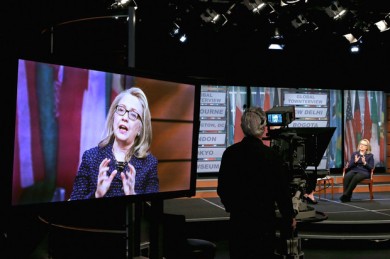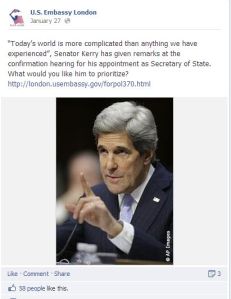Secretary of State Hillary Clinton bid the world a virtual goodbye on Jan. 29 during a “Global Townterview” that allowed journalists and viewers at home to submit questions via Facebook and Twitter. The interactive, digital-friendly event served as a fitting end to her time in the State Department, which was defined by her passion for “21st century statecraft,” the use of social media and other digital platforms to achieve US foreign policy goals. Thanks to her push for innovation, the State Department and its embassies now boast 195 Twitter accounts and 290 Facebook pages with more than 15 million followers.
“21st century statecraft” and its social media strategies naturally go hand-in-hand with public diplomacy, deals with influencing public opinion overseas to promote positive perceptions of the US and build support for its policies. Thanks to its inherent interactive nature, social media fit neatly into Cowan and Arsenault (2008)’s discussion of public diplomacy, which emphasizes the importance of dialogue and citizen participation in winning trust and support from audiences overseas.
The oldest methods of public diplomacy fall into the monologue, or one-way communication, category, which includes speeches, publications, cultural works, Voice of America broadcasts, etc. These certainly have their place in public diplomacy, as they allow the government to convey its ideas or perspectives clearly and eloquently (Cowan and Arsenault, 2008). However, for countries such as the United States with legacies of imperialism and economic and social imbalances, “traditional one-way public diplomacy messages are frequently treated with suspicion” (Cowan and Arsenault, 2008).
As a result, dialogue, also known as two-way communication, is a very necessary part of American public diplomacy. Successful dialogue has been shown to minimize feelings of control and dominance, while helping foreign publics better understand US policies (Cowan and Arsenault, 2008). “Democratization scholars also consistently find that individuals are more likely to feel favorably toward those with opposing viewpoints and consider political outcomes as fair, if not correct, if they have the opportunity to engage in discussion and debate” (Cowan and Arsenault, 2008).
Before the social media era, dialogue-promoting tactics were fairly limited in their scope and reach. Summits, conferences and in-person discussion sessions hosted by embassies, for example, can only reach a relatively small audience of highly-interested, well-educated citizens that live nearby. Call-in talk shows, exchange programs and citizen participation in cross-cultural sports or arts projects can also be effective, but again, they are fairly limited in the number of citizens they impact.
Social media provide a cost-effective and easily accessible platform that gives a much larger group of stakeholders abroad a voice to discuss US policies. With Twitter chats around government-created hashtags, Facebook Q&A sessions and YouTube interviews, the State Department has embraced these new technologies.
“There are just too many people out there yearning for interaction,” said Tara Sonenshine, under secretary for public diplomacy and public affairs at the U.S. Department of State. “But there is no way we can have direct contact with even a small fraction of them. Virtual technology gives us the capability to significantly scale up our engagement opportunities.”
Clearly, despite the current fascination with social media, in-person interactions remain an important part of building relationships and shaping perceptions. As John Brown, who teaches public diplomacy at Georgetown University, told National Public Radio, “Ultimately, what’s most important about public diplomacy in my view is not Facebook to Facebook, but face to face.”
But social media platforms have the potential to promote communication when face-to-face interaction is impossible or extremely difficult, such as in dangerous or unfriendly nations. For example, when the US evacuated its embassy staff from Syria, Ambassador Robert Ford was able to keep in touch with Syrian citizens, follow events on the ground and work to influence them – all via Facebook and Twitter. He engaged Syrian citizens and bloggers in interactive discussions that were able to refute many of the claims being made by the pro-government “Syrian Electronic Army.”
Another example of a highly-praised public diplomacy 2.0 effort is the work of the US ambassador to Russia, Michael McFaul, who uses social media to address rumors in the Russian press and answer citizens’ questions about America. He is also known for adding a personal touch to diplomacy efforts with his bilingual tweets about date nights with his wife. As Cowen and Arsenault (2008) note, these more personal interactions can lessen animosity toward the United States by helping foreign publics differentiate between the American people and American policies.
While social media certainly have the potential for meaningful dialogue and engagement, many critics worry that the United States’ digital strategy is much more interested in the appearance of dialogue than actual conversations (Comor and Bean, 2012). As Comor and Bean point out, true listening involves an occasional policy response that reflects what foreign publics have communicated. Only when the US is willing to consider reforming policies in response to the discussions it encourages on social media will its calls for engagement be perceived as authentic by target audiences (Comor and Bean, 2012). Comor and Bean argue that without this reform the US social media strategy will fail to produce major shifts in public opinion, such as the reduction of anti-American sentiment in the Middle East. Of course, this type of authentic dialogue comes with its own challenges, such as the domestic backlash that would accompany the perception that “foreigners” are dictating American policies (Comor and Bean, 2012).
It is clear that social media, when used effectively, hold a great deal of potential for the State Department. However, to fully capitalize on its benefits, the US must ensure that is really using these platforms for thoughtful, two-way communication, rather than just creating the appearance of dialogue. While foreign policies on key national interests, such as securing oil supplies, will clearly never be determined by social media discussion, the US needs to become more flexible on less important, periphery issues and be receptive to foreign publics’ input.
Works Cited
Comor, E., & Bean, H. (2012, April). “America’s ‘Engagement’ Delusion: Critiquing a Public Diplomacy Consensus.” International Communication Gazette, 74: 203-220.
Cowan, G., & Arsenault, A. (2008, March). “Moving from Monologue to Dialogue to Collaboration: The Three Layers of Public Diplomacy.” The ANNALS of the American Academy of Political and Social Science, 616:10-30.


